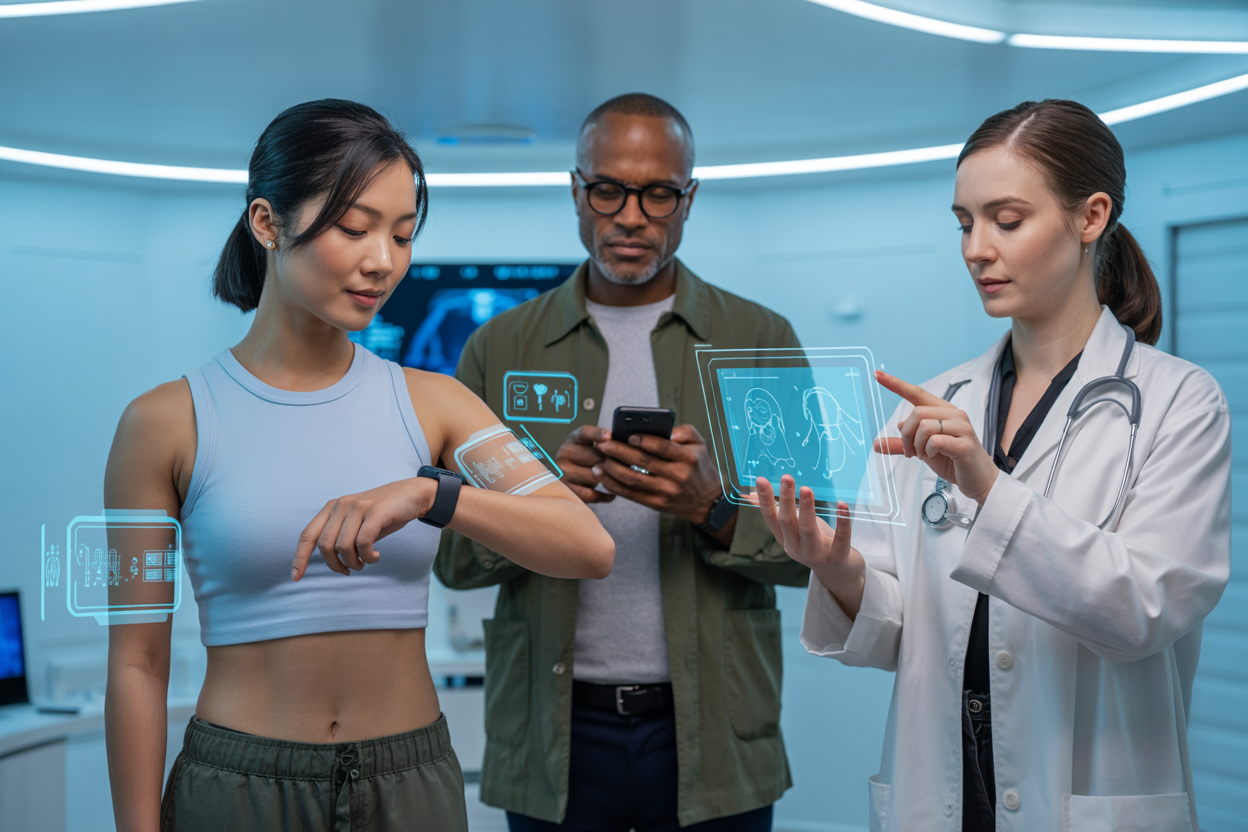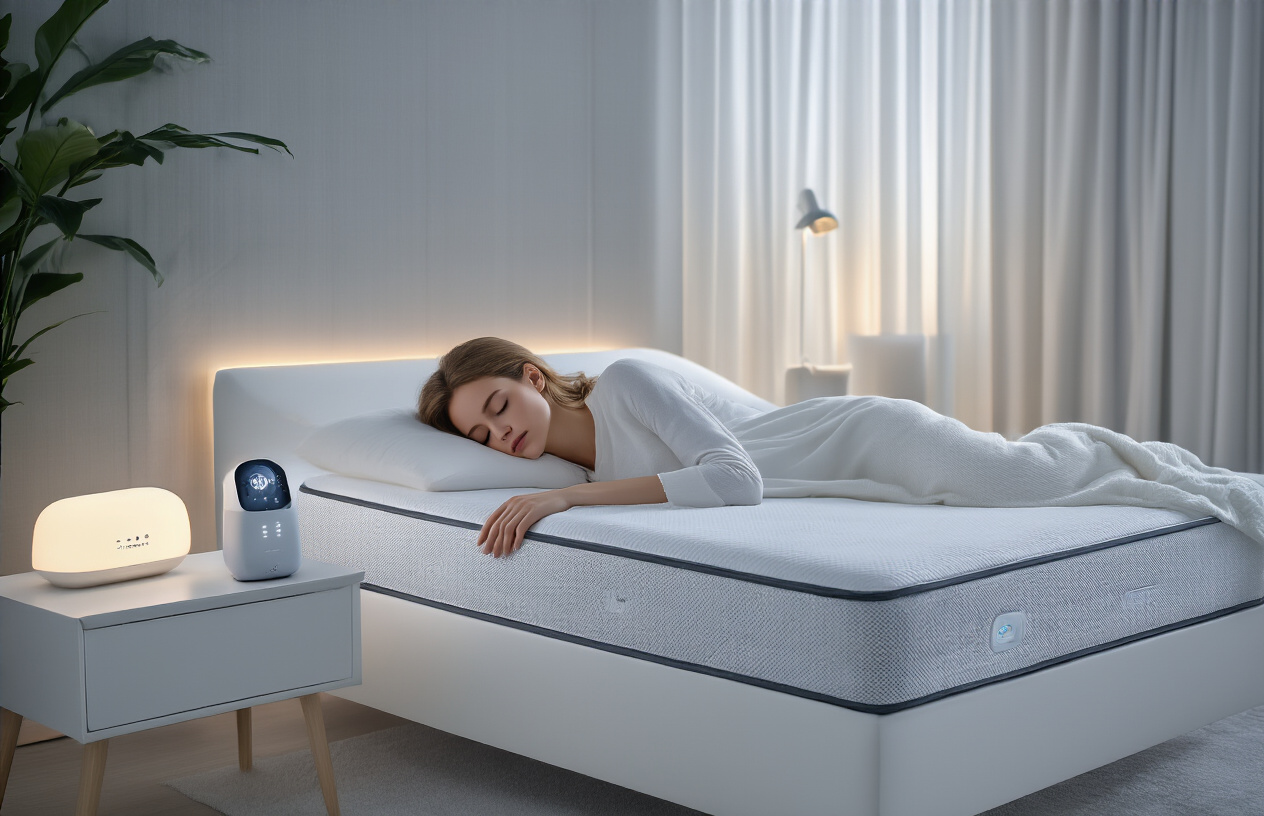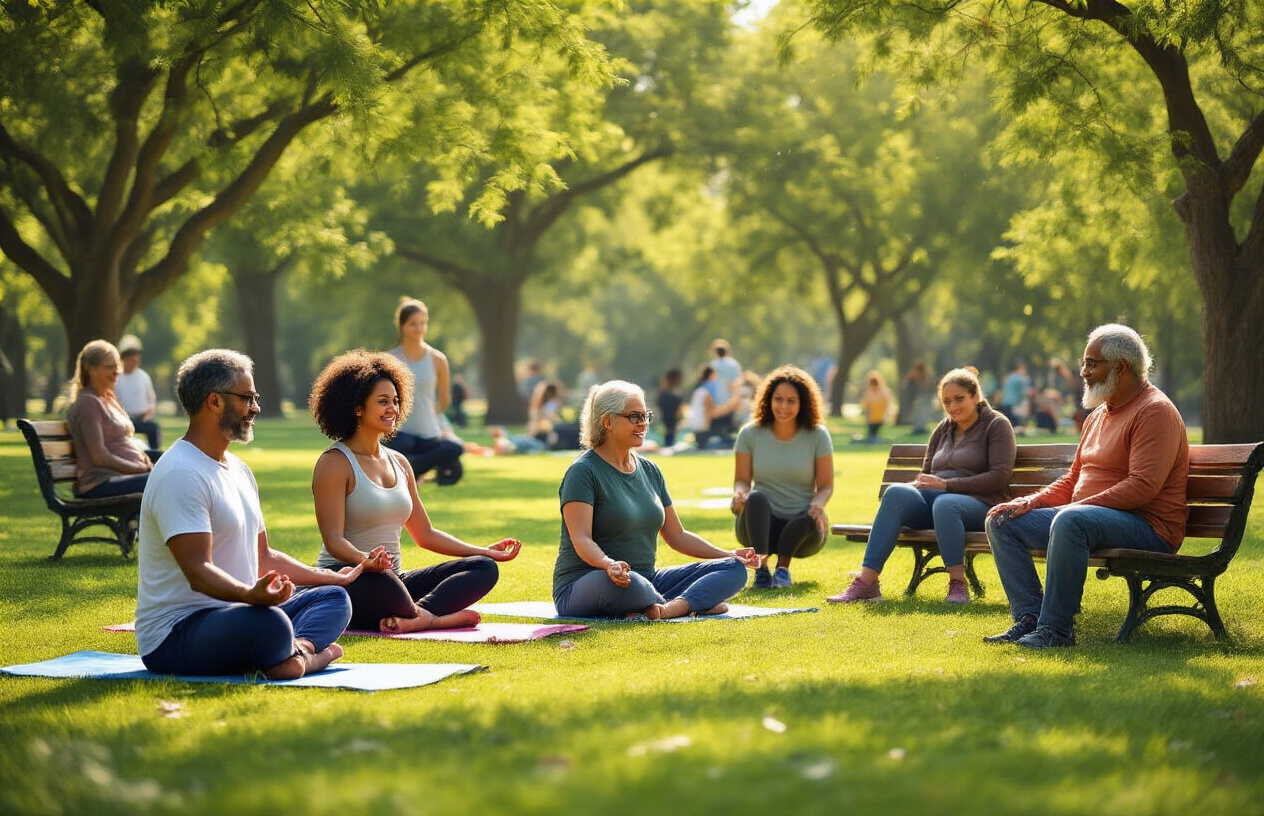Health and wellness are changing fast, and 2025 brings exciting new ways to feel your best. This guide breaks down the top 10 health & lifestyle trends in 2025 you should know, perfect for anyone wanting to stay ahead of the curve and make smarter choices about their wellbeing.
You’ll discover how AI is making personalized health tracking more powerful than ever, giving you insights tailored specifically to your body and lifestyle. We’ll explore why mental health is finally getting the daily attention it deserves, moving beyond quick fixes to become part of your regular routine. Plus, you’ll learn about the gut health revolution that’s changing how we think about everything from mood to immunity.
Get ready to transform how you approach wellness in the year ahead.
AI-Powered Personalized Health Monitoring

Smart wearables that adapt to your unique biomarkers
Gone are the days of one-size-fits-all fitness trackers. Today’s smart wearables learn your body’s unique patterns and adjust their monitoring accordingly. These devices now recognize that your normal heart rate variability might look completely different from your neighbor’s, and they calibrate their alerts and recommendations based on your personal baseline.
Modern wearables track dozens of biomarkers simultaneously – from glucose levels and hydration status to stress hormones and inflammation markers. The Apple Watch Series 10 and devices like the Oura Ring Gen 4 can detect subtle changes in your autonomic nervous system, warning you about potential illness days before symptoms appear. Some cutting-edge models even monitor blood oxygen saturation continuously and can spot early signs of sleep apnea or respiratory issues.
What makes these devices truly revolutionary is their machine learning capabilities. They don’t just collect data – they understand what that data means for you specifically. Your device learns when you typically feel energetic, how your body responds to different foods, and what environmental factors affect your performance.
Real-time health predictions and early warning systems
Predictive health monitoring represents the biggest leap forward in preventive care. Advanced algorithms now analyze patterns in your biometric data to forecast health events before they happen. These systems can predict everything from migraine episodes and panic attacks to more serious conditions like cardiac events or diabetic episodes.
The technology works by identifying subtle physiological changes that precede health issues. For instance, your wearable might notice a specific combination of elevated resting heart rate, decreased heart rate variability, and changes in skin temperature that historically occur 48 hours before you get sick. The system then sends you personalized recommendations – maybe suggesting you increase your vitamin C intake, get more sleep, or avoid strenuous exercise.
Companies like Whoop and Garmin have developed sophisticated recovery algorithms that predict your optimal training intensity for each day. These systems prevent overtraining injuries by analyzing your sleep quality, previous day’s stress, and current readiness scores. Some devices can even predict when you’re at higher risk for accidents due to fatigue or stress levels.
Customized supplement and nutrition recommendations
Your wearable device now functions as a personal nutritionist, analyzing your real-time nutritional needs based on your activity levels, stress markers, and metabolic data. Advanced glucose monitors like the Freestyle Libre 3 provide continuous insights into how different foods affect your blood sugar, allowing for meal timing and composition adjustments that optimize energy levels throughout the day.
AI-powered platforms integrate data from multiple sources – your wearable, food diary, sleep tracker, and even genetic testing results – to create highly personalized supplement protocols. These recommendations change dynamically based on factors like seasonal changes, travel, illness, or increased training loads.
For example, during periods of high stress detected by your device, the system might recommend adaptogens like ashwagandha or rhodiola. During intense training phases, it might suggest increasing magnesium and omega-3 fatty acids. Some platforms even partner with supplement companies to deliver customized vitamin packs that adjust monthly based on your changing health metrics.
Sleep optimization through advanced tracking technology
Sleep tracking has evolved far beyond counting hours. Current technology analyzes sleep architecture, tracking the precise timing and quality of each sleep stage. Devices now monitor brain waves, breathing patterns, heart rate variability, body temperature fluctuations, and environmental factors like room temperature and noise levels.
Smart sleep systems create personalized sleep environments that automatically adjust throughout the night. Your mattress might cool down during deep sleep phases and gradually warm as you approach morning wake time. Smart lighting systems mimic natural circadian rhythms, gradually dimming blue light in the evening and increasing it in the morning.
Advanced sleep coaches use AI to identify the specific factors disrupting your sleep and provide targeted interventions. Maybe your device discovers that your deep sleep quality drops when you exercise within four hours of bedtime, or that your REM sleep improves significantly when you maintain a consistent bedtime routine. These insights lead to highly personalized sleep hygiene recommendations that actually work for your unique physiology.
Mental Health Integration in Daily Wellness Routines

Micro-meditation practices for busy professionals
Time-crunched professionals are discovering that mental wellness doesn’t require hour-long meditation retreats. Brief, targeted mindfulness sessions lasting just 2-5 minutes can deliver measurable stress reduction and improved focus throughout the workday.
The 3-2-1 breathing technique has gained massive popularity among executives. Simply breathe in for 3 counts, hold for 2, and exhale for 1. This quick reset can be done between meetings or during commute times. Tech leaders at major corporations report using this technique up to 10 times daily.
Desk-based body scans offer another powerful option. Starting from the top of your head, mentally check in with each body part for tension, spending just 30 seconds on each area. This practice helps identify stress accumulation before it becomes overwhelming.
Walking meditations transform routine activities into mindfulness moments. Whether moving between conference rooms or walking to lunch, focusing on each step and breath pattern turns necessary movement into mental health maintenance.
Apps like Headspace for Work and Calm for Business now offer specialized programs designed for office environments, featuring sessions that work around meeting schedules and workplace noise levels.
Mental health apps with professional therapist support
The mental health app landscape has evolved beyond basic meditation timers to comprehensive platforms offering real human connection. Professional therapist integration represents the biggest shift in digital wellness, bridging the gap between self-help tools and clinical care.
BetterHelp and Talkspace now seamlessly integrate with wellness tracking apps, allowing therapists to view mood patterns, sleep data, and stress indicators between sessions. This continuous monitoring helps professionals provide more targeted interventions and catch concerning trends early.
Crisis intervention features have become standard across platforms. Apps like Sanvello and MindShift offer immediate access to licensed professionals during mental health emergencies, with 24/7 chat support and video calling capabilities.
Personalized therapy matching uses AI algorithms to connect users with therapists who specialize in their specific challenges. These systems consider factors like communication style preferences, cultural background, and treatment approach compatibility.
Group therapy integration allows app users to join virtual support groups led by licensed facilitators. This hybrid approach combines the convenience of digital access with the proven benefits of peer support and professional guidance.
Insurance coverage for app-based therapy has expanded dramatically, with major providers now covering sessions conducted through approved platforms, making professional mental health support more accessible than ever.
Workplace wellness programs focusing on psychological safety
Progressive companies recognize that psychological safety directly impacts productivity, retention, and overall business success. Modern workplace wellness programs prioritize creating environments where employees feel safe to express concerns, make mistakes, and seek help without fear of judgment or retaliation.
Manager training programs now include modules on recognizing signs of employee mental health struggles and appropriate response techniques. Leaders learn to have difficult conversations while maintaining professional boundaries and knowing when to refer employees to professional resources.
Anonymous feedback systems allow employees to report workplace stressors, toxic behaviors, or mental health concerns without revealing their identity. Companies like Google and Microsoft use these insights to make targeted improvements to work culture and policies.
Flexible mental health days go beyond traditional sick leave, offering employees dedicated time for psychological wellness without requiring medical documentation. Some organizations provide unlimited mental health days, recognizing that prevention is more cost-effective than crisis intervention.
On-site counseling services are becoming standard benefits packages. Companies partner with mental health providers to offer confidential counseling sessions during work hours, eliminating barriers like scheduling conflicts and transportation issues.
Stress reduction initiatives include everything from therapy dogs and meditation rooms to mandatory lunch breaks and email curfews after business hours. These programs acknowledge that sustainable productivity requires protecting employee mental resources.
Sustainable and Plant-Forward Nutrition Approaches

Lab-grown meat alternatives becoming mainstream
2025 marks the tipping point for cultivated meat as production costs plummet and regulatory approvals expand globally. Companies like UPSIDE Foods and GOOD Meat have scaled their operations, making lab-grown chicken and beef available in major grocery chains at prices competitive with conventional meat. The technology has advanced beyond basic muscle tissue to include complex textures and marbling patterns that closely mimic traditional cuts.
Consumer acceptance has skyrocketed as taste tests consistently show minimal differences between cultivated and conventional products. Major food chains are introducing cultivated meat options, with some restaurants featuring “future meat” menus that showcase the technology’s versatility. The environmental benefits are compelling – cultivated meat produces 96% fewer greenhouse gas emissions and uses 99% less land than traditional livestock farming.
Investment in cellular agriculture infrastructure has reached unprecedented levels, with vertical farms dedicated to meat cultivation appearing in urban centers worldwide. This localized production model reduces transportation emissions and ensures fresher products reach consumers faster.
Personalized plant-based meal planning systems
AI-driven nutrition platforms are revolutionizing how people approach plant-based eating by analyzing individual biomarkers, genetic data, and lifestyle factors to create customized meal plans. Apps like PlantNet Pro and VegaGenome use continuous glucose monitoring data, micronutrient testing results, and digestive health assessments to recommend optimal plant combinations for each person’s unique needs.
These systems account for factors like protein synthesis efficiency, mineral absorption rates, and inflammatory responses to specific foods. The technology identifies potential nutritional gaps in plant-based diets and suggests targeted food pairings to maximize nutrient absorption. For example, the system might recommend consuming vitamin C-rich foods alongside iron-heavy leafy greens to enhance mineral uptake.
Smart kitchen integration allows these platforms to automatically order ingredients, adjust portion sizes based on activity levels, and even sync with meal prep services that deliver pre-portioned ingredients optimized for individual nutritional profiles. Weekly blood panels and continuous health monitoring provide real-time feedback, allowing the AI to refine recommendations and track how dietary changes impact energy levels, cognitive function, and overall wellness markers.
Zero-waste cooking and food storage methods
Home kitchens are embracing circular economy principles through innovative preservation technologies and waste elimination strategies. Vacuum fermentation systems allow households to transform food scraps into nutrient-dense probiotics and flavor enhancers, while smart dehydrators create custom spice blends from vegetable peels and herb stems.
Advanced storage solutions include climate-controlled pantry systems that extend produce life by up to 400% through precise humidity and ethylene gas management. These units monitor each item’s ripeness and automatically adjust conditions to slow degradation. Smart containers with built-in sensors track freshness and suggest recipes based on ingredients nearing expiration.
Root-to-stem cooking has evolved into a science-backed practice, with nutritionists providing detailed guides on maximizing the nutritional value of typically discarded plant parts. Broccoli stems become high-fiber rice alternatives, citrus peels transform into immune-boosting teas, and vegetable scraps create mineral-rich broths through pressure extraction methods.
Community sharing networks have emerged where neighbors exchange surplus produce through app-based platforms, creating local food webs that minimize waste while strengthening social connections. These systems use predictive algorithms to match excess food with households that need specific ingredients.
Local sourcing and community-supported agriculture
Regional food systems are experiencing unprecedented growth as consumers prioritize transparency, freshness, and environmental sustainability. Community-supported agriculture (CSA) programs have evolved beyond traditional vegetable boxes to include year-round offerings of preserved foods, fermented products, and value-added items like plant-based proteins made from locally grown legumes.
Urban farming initiatives are transforming city landscapes through vertical growing systems integrated into residential and commercial buildings. Rooftop greenhouses, basement hydroponic systems, and vacant lot conversions create food production hubs within walking distance of consumers. These facilities use 90% less water than traditional farming while producing yields up to 10 times higher per square foot.
Farm-to-table partnerships have become more sophisticated, with restaurants investing directly in local producers to secure consistent supplies of specialty crops. Some establishments operate their own micro-farms on-site, growing herbs, microgreens, and specialty vegetables in controlled environments that guarantee optimal flavor and nutrition.
Technology platforms now connect consumers directly with local farmers through subscription services that deliver seasonal produce within hours of harvest. GPS tracking shows exactly where food was grown, while blockchain systems verify organic certifications and sustainable farming practices, creating complete supply chain transparency that builds trust between producers and consumers.
Longevity-Focused Lifestyle Interventions

Intermittent Fasting Protocols for Cellular Regeneration
The science behind intermittent fasting has evolved dramatically, revealing its powerful impact on cellular renewal through autophagy – your body’s natural housekeeping process. Modern protocols go beyond basic 16:8 schedules, incorporating strategic fasting windows designed to maximize cellular repair while maintaining metabolic flexibility.
Popular Evidence-Based Protocols:
| Protocol | Fasting Window | Eating Window | Best For |
|---|---|---|---|
| 16:8 | 16 hours | 8 hours | Beginners, daily routine |
| 18:6 | 18 hours | 6 hours | Enhanced autophagy |
| OMAD | 23 hours | 1 hour | Advanced practitioners |
| 5:2 | 2 days/week | 5 normal days | Flexible schedules |
The key lies in personalization based on your circadian rhythm, workout schedule, and metabolic health markers. Research shows that extending fasting periods to 18+ hours significantly increases autophagy markers, while shorter windows still provide metabolic benefits without the stress response.
Timing matters enormously. Early time-restricted eating (stopping food intake by 3 PM) shows superior results for insulin sensitivity compared to late eating windows. Your body’s natural cortisol patterns and growth hormone release work synergistically with strategic fasting to optimize cellular regeneration.
Cold Therapy and Heat Shock Protein Activation
Cold exposure has transformed from a wellness fad into a scientifically-backed longevity tool. Regular cold therapy triggers heat shock proteins (HSPs) – molecular chaperones that protect and repair cellular structures, essentially giving your cells a tune-up at the molecular level.
Effective Cold Therapy Methods:
- Cold plunges: 50-59°F for 2-4 minutes, 3-4 times weekly
- Cryotherapy chambers: -200°F for 2-3 minutes
- Cold showers: Finish with 30-90 seconds of cold water
- Ice baths: 10-15 minutes at 50-55°F
The magic happens through hormesis – controlled stress that makes you stronger. Cold exposure activates brown adipose tissue, boosts norepinephrine production, and enhances mitochondrial biogenesis. Studies show regular cold therapy can increase longevity markers like SIRT1 expression and improve cardiovascular health.
Combining cold with heat therapy (sauna sessions) creates an even more powerful hormetic response. Finnish research demonstrates that 4-7 sauna sessions weekly can reduce all-cause mortality by up to 40%. The contrast between hot and cold treatments amplifies heat shock protein production and improves vascular function dramatically.
Blue Zone Lifestyle Adoption in Urban Environments
Blue Zones – regions where people routinely live past 100 – offer proven blueprints for longevity that urban dwellers can adapt without relocating to Sardinia or Okinawa. The challenge lies in translating traditional practices into modern city living while maintaining their essential benefits.
Core Blue Zone Principles for City Life:
- Movement naturally: Walk for errands, take stairs, practice “exercise snacking” throughout the day
- Purpose-driven living: Identify your “ikigai” or life purpose and align daily activities accordingly
- Plant-forward eating: Adopt the 95% plant-based dietary patterns common across Blue Zones
- Social connections: Create chosen family networks and maintain intergenerational relationships
Urban Blue Zone adaptation focuses on micro-communities within larger cities. Co-housing projects, neighborhood walking groups, and community gardens recreate the tight social bonds essential for longevity. Technology can support these connections rather than replace them – apps that connect neighbors for meal sharing or local skill exchanges.
The eating patterns prove most adaptable. Blue Zone diets emphasize legumes, whole grains, vegetables, and minimal processed foods. Urban meal prep services now offer Blue Zone-inspired meal plans, while community-supported agriculture provides fresh, local produce that mirrors traditional food systems.
Creating sacred daily rituals – morning walks, evening reflection, family dinners – helps establish the rhythm and purpose that characterize centenarian communities worldwide.
Advanced Sleep Science and Recovery Methods

Circadian Rhythm Optimization Through Light Therapy
Your internal clock runs on a precise 24-hour cycle that controls everything from hormone release to body temperature. Light exposure plays the starring role in keeping this biological timekeeper synchronized with the outside world. Smart light therapy devices now offer personalized solutions that adjust color temperature and intensity throughout the day, mimicking natural sunlight patterns even when you’re stuck indoors.
Red light therapy has gained serious traction for its ability to promote melatonin production in the evening hours. These devices emit wavelengths between 660-850 nanometers, which don’t disrupt your natural wind-down process like blue light from screens. Morning light boxes delivering 10,000 lux can reset your circadian rhythm after jet lag or shift work, while circadian lighting systems automatically dim and warm up as bedtime approaches.
Wearable light therapy devices are becoming more sophisticated, with some models tracking your sleep patterns and delivering targeted light pulses during specific sleep phases. The science shows that even brief exposure to bright light during your biological night can shift your entire sleep-wake cycle by several hours within just a few days.
Sleep Environment Customization for Maximum Restoration
Your bedroom environment directly impacts sleep quality more than most people realize. Temperature regulation takes center stage here – your core body temperature naturally drops as you prepare for sleep, and maintaining a room temperature between 65-68°F supports this process. Smart mattresses and cooling systems now offer zone-based temperature control, keeping different areas of your bed at optimal temperatures for you and your partner.
Air quality monitoring has become essential for sleep optimization. Poor air circulation, high CO2 levels, or allergens can fragment your sleep cycles without you even knowing it. Advanced air purification systems with real-time monitoring adjust filtration and humidity levels automatically based on sleep phases detected through integrated sensors.
Sound masking technology has evolved beyond basic white noise machines. Adaptive soundscapes now respond to external noise pollution, automatically adjusting volume and frequency to maintain consistent ambient sound levels. Some systems even incorporate binaural beats tuned to specific brainwave patterns associated with deep sleep stages.
Blackout solutions have gotten smarter too. Automated window treatments sync with your circadian rhythm preferences, gradually increasing light exposure during your natural wake window while maintaining complete darkness during deep sleep phases.
Recovery-Focused Exercise Scheduling
Timing your workouts around your natural energy cycles can dramatically improve both exercise performance and recovery quality. Your body temperature, hormone levels, and reaction times all fluctuate predictably throughout the day, creating windows where certain types of exercise yield better results with less stress on your system.
High-intensity training works best when your core body temperature peaks in late afternoon or early evening. Your perceived exertion rates drop during these hours, allowing you to push harder with the same subjective effort. Morning workouts, while great for establishing routine, require longer warm-up periods since your joints are stiffer and your nervous system needs time to fully activate.
Recovery timing matters just as much as exercise timing. Your growth hormone peaks during the first few hours of sleep, making post-workout nutrition timing critical for muscle repair. Consuming protein within two hours after evening workouts supports this natural recovery window, while morning exercisers benefit from splitting their protein intake throughout the day.
Sleep tracking data now guides exercise scheduling decisions. Many athletes use heart rate variability measurements taken each morning to determine training intensity for that day. Lower HRV scores indicate your nervous system needs more recovery time, suggesting lighter exercise loads or complete rest days. This data-driven approach prevents overtraining while maximizing adaptation from your workouts.
Functional Movement and Injury Prevention

Movement Screening Technology for Personalized Exercise
Advanced motion capture technology and AI-driven movement assessment tools are changing how we approach fitness programming. Apps like OnBase and PUSH use computer vision to analyze your movement patterns in real-time, identifying muscle imbalances, mobility restrictions, and compensation patterns that could lead to injury.
These systems track everything from your squat depth to your shoulder mobility, creating detailed movement profiles that personal trainers and physical therapists can use to design targeted exercise programs. Wearable sensors attached to key body points provide instant feedback on movement quality, helping you correct form before bad habits become ingrained.
The technology goes beyond basic form checking. Machine learning algorithms compare your movements to thousands of other users with similar body types and fitness levels, providing personalized recommendations for mobility work, strength training, and injury prevention strategies.
Mobility-First Fitness Programs Over High-Intensity Training
The fitness industry is shifting away from the “no pain, no gain” mentality toward mobility-centered approaches that prioritize joint health and movement quality over intensity. Programs like Functional Range Conditioning (FRC) and MovNat focus on building functional strength through full ranges of motion rather than maximum load lifting.
This approach recognizes that most people spend hours in sedentary positions, creating tight hip flexors, rounded shoulders, and limited ankle mobility. Before adding heavy weights or high-impact movements, these programs address fundamental movement patterns and joint mobility.
Popular mobility-first programs include:
- Daily movement flows that combine yoga, pilates, and functional movement patterns
- Animal movement patterns like bear crawls and lizard walks that build strength through natural ranges of motion
- Breathwork integration with movement to enhance nervous system regulation
- Joint-by-joint mobility assessments that target specific areas of restriction
Workplace Ergonomics and Posture Correction Systems
Smart office technology is tackling the epidemic of desk-related injuries and postural dysfunction. Posture monitoring devices like Upright Go and Lumo Lift provide gentle vibrations when you slouch, training your body to maintain proper alignment throughout the day.
Standing desks now come with built-in sensors that remind you to alternate between sitting and standing, while apps track your movement patterns and suggest micro-breaks for stretching and movement. Some companies are investing in ergonomic assessments using 3D body scanning to customize workstation setups for each employee.
The latest workplace wellness programs include:
| Technology | Function | Benefits |
|---|---|---|
| Smart chairs | Pressure sensors detect posture changes | Real-time feedback, automatic adjustments |
| Desk bikes | Pedal while working | Improved circulation, reduced sedentary time |
| Movement apps | Scheduled break reminders | Reduced muscle tension, increased productivity |
| Ergonomic keyboards | Split designs reduce wrist strain | Lower risk of repetitive stress injuries |
Age-Specific Movement Patterns and Joint Preservation
Exercise programming is becoming more sophisticated in addressing the unique needs of different age groups. For older adults, programs focus on balance training, fall prevention, and maintaining bone density through weight-bearing exercises. Younger populations benefit from movement variability and injury prevention strategies that prepare them for decades of active living.
Research shows that certain movement patterns become more critical as we age. Hip hinge movements help maintain functional independence for activities like getting out of chairs, while rotational exercises preserve spine mobility that naturally decreases over time.
Age-specific considerations include:
- 20s-30s: Building movement foundations, addressing tech neck and hip flexor tightness
- 40s-50s: Hormone-aware training, joint decompression, and stress management through movement
- 60s+: Balance challenges, bone loading exercises, and cognitive-movement integration
The key lies in matching exercise intensity and complexity to individual capacity while progressively challenging the body to maintain and improve function across the lifespan.
Gut Health Revolution and Microbiome Optimization

Personalized Probiotic Therapies Based on Genetic Testing
Your gut microbiome is as unique as your fingerprint, and 2025 marks the year when probiotic treatments finally catch up to this reality. Advanced genetic testing now reveals exactly which bacterial strains your body needs most, moving far beyond the one-size-fits-all approach of traditional probiotics.
Companies like Viome and Thryve are leading this revolution by analyzing your microbiome composition alongside genetic markers that influence digestion, inflammation response, and nutrient metabolism. The results? Customized probiotic formulations that target your specific imbalances.
These personalized therapies address conditions ranging from IBS and food sensitivities to mood disorders and immune dysfunction. Clinical trials show success rates up to 70% higher than standard probiotics when treatments match individual microbiome profiles.
| Testing Method | Information Provided | Typical Cost | Turnaround Time |
|---|---|---|---|
| 16S rRNA Sequencing | Bacterial diversity & composition | $150-300 | 2-4 weeks |
| Shotgun Metagenomics | Complete microbial functions | $300-500 | 3-6 weeks |
| Metabolomics Testing | Microbial byproducts & activity | $400-700 | 4-8 weeks |
The process typically involves collecting stool and saliva samples, receiving detailed reports about your current microbiome state, and following targeted supplementation protocols that evolve as your gut health improves.
Fermented Food Integration in Modern Diets
Fermented foods are experiencing a renaissance that goes way beyond trendy kombucha bars. Modern nutritionists now prescribe specific fermented foods as functional medicine, recognizing their power to reshape entire microbiome ecosystems.
The 2025 approach focuses on strategic fermentation diversity rather than random consumption. Different fermented foods introduce unique bacterial strains and bioactive compounds that serve distinct health purposes:
Daily Rotation Protocol:
- Morning: Kefir or yogurt with live cultures for Lactobacillus boost
- Midday: Fermented vegetables like sauerkraut or kimchi for fiber-digesting bacteria
- Evening: Miso or tempeh for evening digestive support
Home fermentation has exploded in popularity as people seek control over their probiotic intake. Simple setups for fermenting vegetables, dairy, and even grains cost under $50 and provide fresh probiotics year-round. Popular starter cultures like water kefir grains and SCOBY mushrooms can be shared within communities, creating local fermentation networks.
Restaurant menus increasingly feature fermented elements, with chefs collaborating with microbiologists to create dishes that deliver specific probiotic benefits. This isn’t just about taste anymore – it’s precision nutrition through ancient preservation techniques.
Gut-Brain Connection Protocols for Mental Clarity
The gut-brain axis has moved from fringe science to mainstream medicine, with specific protocols now targeting mental performance through microbiome optimization. Research shows that 90% of serotonin production occurs in the gut, making digestive health a direct pathway to better mood and cognitive function.
Evidence-Based Protocols Include:
Morning Gut-Brain Reset:
- 10-minute meditation while consuming prebiotic-rich foods
- Specific probiotic strains like Lactobacillus helveticus R0052 for anxiety reduction
- Cold exposure therapy to stimulate vagus nerve communication
Cognitive Enhancement Stack:
- Targeted omega-3 supplementation for brain-gut inflammation control
- Intermittent fasting windows that allow gut bacteria to communicate freely with neural pathways
- Psychobiotic foods rich in GABA-producing bacteria
Mental health professionals now routinely test gut health markers when treating depression, anxiety, and brain fog. Stool analysis reveals inflammatory patterns that often correlate with mental health symptoms, leading to treatment plans that address root causes rather than just managing symptoms.
The vagus nerve serves as the primary communication highway between gut and brain. Specific breathing exercises, cold therapy, and even targeted probiotic strains can strengthen this connection, leading to measurable improvements in focus, memory, and emotional regulation within 4-6 weeks of consistent practice.
Digital Detox and Mindful Technology Usage

Scheduled Offline Periods for Cognitive Restoration
Taking regular breaks from digital devices has become essential for mental clarity and focus. Research shows that constant connectivity creates cognitive overload, making it harder to process information and make decisions. Setting specific times each day to disconnect allows your brain to reset and recover from digital stimulation.
The most effective approach involves implementing structured “digital sabbaths” – designated hours where all non-essential devices are turned off or placed in airplane mode. Many people find success with morning offline periods (first hour after waking) and evening wind-downs (last hour before sleep). During these times, your prefrontal cortex can engage in deeper thinking processes without the constant interruption of notifications.
Weekend digital detox sessions prove particularly beneficial for long-term cognitive health. Consider implementing 4-6 hour offline blocks where you engage in analog activities like reading physical books, cooking, or creative hobbies. This extended disconnection helps restore attention span and reduces the anxiety that comes from constant connectivity.
Blue Light Management and Eye Health Protection
Digital screens emit high-energy blue light that can disrupt natural circadian rhythms and cause eye strain. Extended exposure leads to digital eye syndrome, characterized by dry eyes, blurred vision, and headaches. Managing blue light exposure requires both technological solutions and behavioral changes.
Blue light filtering glasses have gained popularity, but their effectiveness varies significantly between brands and individuals. More reliable approaches include adjusting device settings to reduce blue light emission, especially during evening hours. Most smartphones and computers now offer built-in blue light filters that automatically adjust screen temperature based on time of day.
The 20-20-20 rule remains one of the most effective strategies for eye health: every 20 minutes, look at something 20 feet away for 20 seconds. This simple practice helps relax the focusing muscles in your eyes and reduces strain. Additionally, maintaining proper screen distance (arm’s length for computers, slightly farther for TVs) and ensuring adequate ambient lighting can significantly reduce eye fatigue.
Social Media Consumption Guidelines for Mental Wellness
Social media platforms are designed to capture and hold attention, often leading to mindless scrolling that can negatively impact mental health. Establishing clear boundaries around social media use helps maintain psychological well-being while still enjoying the benefits of digital connection.
Time-based limits work better than complete avoidance for most people. Setting daily limits of 30-60 minutes for recreational social media use allows for meaningful connection without falling into comparison traps or endless scrolling cycles. Using built-in screen time controls or third-party apps helps track and enforce these boundaries automatically.
Curating your feeds intentionally makes a significant difference in mental health outcomes. Unfollow accounts that consistently trigger negative emotions or comparison behaviors. Instead, prioritize content that inspires, educates, or genuinely entertains you. Consider following accounts related to your hobbies, professional interests, or causes you care about rather than lifestyle or appearance-focused content.
The quality of engagement matters more than quantity. Meaningful interactions – commenting thoughtfully, sharing genuinely helpful content, or using platforms to maintain real relationships – contribute positively to well-being. Passive consumption, particularly of highly curated lifestyle content, often leads to increased anxiety and decreased life satisfaction.
Nature-Based Activities to Counterbalance Screen Time
Spending time in natural environments provides the perfect antidote to digital overstimulation. Nature exposure reduces cortisol levels, improves mood, and helps restore directed attention capacity that gets depleted by screen use. Even brief periods outdoors can provide significant cognitive and emotional benefits.
Forest bathing, or “shinrin-yoku,” involves mindfully immersing yourself in natural settings without specific goals or distractions. This practice originated in Japan and involves slow, deliberate observation of natural elements – the texture of tree bark, the sound of rustling leaves, or the patterns of light filtering through branches. Research shows that just 15-20 minutes of forest bathing can lower stress hormones and boost immune function.
Gardening offers another powerful way to reconnect with the natural world while engaging in purposeful, screen-free activity. Whether tending to houseplants, maintaining a small balcony garden, or working in a community garden, this hands-on interaction with growing things provides grounding and satisfaction that digital activities rarely match.
Urban nature experiences count too. Walking in parks, sitting by water features, or even spending time on green rooftops can provide similar benefits to more remote natural settings. The key is intentional engagement with natural elements rather than treating outdoor time as just another opportunity for phone use or photo-taking.
Regular hiking or walking in natural settings without devices creates space for reflection and creative thinking. Many people report their best ideas come during these analog outdoor activities, when the mind is free from digital input and can engage in the kind of wandering thought processes that lead to insights and problem-solving.
Preventive Healthcare Through Early Detection

At-home diagnostic testing for common health markers
Home testing kits have transformed how we monitor our health, putting lab-quality diagnostics right in our living rooms. These convenient tools now measure everything from cholesterol levels and blood glucose to hormone panels and vitamin deficiencies with just a finger prick or saliva sample.
Companies like Everlywell, LetsGetChecked, and Quest Direct offer comprehensive panels that track key biomarkers including:
- Lipid profiles for cardiovascular health assessment
- HbA1c levels for diabetes monitoring
- Thyroid function tests (TSH, T3, T4)
- Vitamin D, B12, and folate levels
- Inflammatory markers like C-reactive protein
- Sex hormones and cortisol levels
The accuracy of these tests now rivals traditional lab work, with many using the same equipment and methodologies. Results typically arrive within days through secure online portals, often accompanied by personalized recommendations from healthcare professionals.
This shift empowers people to catch potential issues before they become serious problems. Regular monitoring helps establish personal baselines, making it easier to spot concerning trends early. The convenience factor means testing happens more frequently, creating a continuous picture of health rather than sporadic snapshots during annual checkups.
Genetic screening for proactive health planning
Direct-to-consumer genetic testing has evolved far beyond ancestry mapping to become a powerful tool for health planning. Modern genetic screens analyze hundreds of thousands of genetic variants to identify predispositions to common conditions like heart disease, diabetes, and certain cancers.
Companies such as 23andMe Health, ApoE Gene Test, and Color Genomics now offer comprehensive health reports that include:
| Test Category | What It Reveals | Actionable Insights |
|---|---|---|
| Disease Risk | Genetic predisposition to conditions | Early screening schedules |
| Drug Response | Medication metabolism variations | Personalized dosing recommendations |
| Nutrient Processing | Vitamin absorption and metabolism | Targeted supplementation plans |
| Fitness Response | Exercise and recovery genetics | Optimized training protocols |
The real value comes from translating genetic information into actionable lifestyle changes. Someone with elevated genetic risk for type 2 diabetes might implement stricter dietary monitoring and increase physical activity decades before symptoms appear. Those with genetic variants affecting medication metabolism can work with doctors to avoid adverse drug reactions.
Genetic counselors increasingly help interpret results, ensuring people understand their risks without falling into genetic determinism. The goal isn’t to create anxiety but to enable informed decisions about screening frequency, lifestyle modifications, and preventive treatments.
Regular biomarker tracking for optimal aging
Biomarker monitoring has become the foundation of personalized aging strategies, moving beyond basic health maintenance toward optimization. Advanced panels now track dozens of aging-related markers that reveal how well your body is maintaining itself at the cellular level.
Key biomarkers for tracking biological age include:
Metabolic Health Indicators:
- Fasting glucose and insulin sensitivity
- Lipid particle size and number
- Inflammatory markers (IL-6, TNF-alpha)
- Oxidative stress levels
Longevity Markers:
- Telomere length measurements
- NAD+ levels and mitochondrial function
- Growth hormone and IGF-1 levels
- Advanced glycation end products (AGEs)
Cardiovascular Aging:
- Arterial stiffness measurements
- Endothelial function tests
- Homocysteine and Lp(a) levels
Companies like InsideTracker, Function Health, and Opus23 Explorer create comprehensive dashboards that track these markers over time, revealing biological age versus chronological age. The data helps identify which interventions work best for each individual.
Regular tracking reveals patterns invisible to standard medical tests. Slight upticks in inflammatory markers might prompt dietary changes months before symptoms appear. Declining NAD+ levels could indicate the need for specific supplements or lifestyle modifications.
This approach treats aging as a modifiable process rather than an inevitable decline, using data to guide interventions that maintain vitality and prevent age-related diseases before they manifest.
Community-Centered Wellness and Social Health

Group Fitness and Accountability Partnerships
The solo workout era is rapidly shifting toward collaborative fitness experiences that harness the power of social motivation. Group fitness classes are evolving beyond traditional formats, incorporating technology-driven challenges where participants track progress together through wearable devices and fitness apps. These digital accountability partnerships create virtual teams that compete in step challenges, workout streaks, and wellness goals throughout the week.
Boutique fitness studios are pioneering “pod training” systems where small groups of 4-6 people commit to long-term fitness journeys together. These pods meet consistently with the same trainer, creating deeper relationships and shared accountability that traditional drop-in classes can’t match. Members report 40% higher adherence rates compared to individual training sessions.
Corporate wellness programs are embracing team-based fitness initiatives, with companies organizing walking groups, lunch-hour yoga sessions, and inter-department fitness competitions. These programs show measurable improvements in employee engagement and reduce healthcare costs while building stronger workplace relationships.
Intergenerational Wellness Programs
Fitness centers and community organizations are breaking down age barriers by creating programs that bring different generations together for mutual benefit. Senior citizens serve as wisdom mentors in meditation and mindfulness classes while younger participants offer technical support for fitness tracking apps and social media wellness challenges.
“Grandparent and Me” fitness classes combine low-impact exercises suitable for older adults with playful movements that engage children and grandchildren. These sessions focus on balance, coordination, and flexibility while creating meaningful bonding experiences across generations.
Community gardens represent another powerful intergenerational wellness trend, where experienced gardeners share knowledge about sustainable food production while younger volunteers contribute physical labor and fresh perspectives on organic growing methods. These programs address nutrition education, physical activity, and social connection simultaneously.
Local Wellness Communities and Support Networks
Neighborhood-based wellness initiatives are replacing impersonal gym memberships with intimate community connections. Local wellness circles organize regular activities like group hikes, healthy cooking classes, and stress management workshops that bring neighbors together around shared health goals.
Community wellness centers are becoming hubs for holistic health resources, offering everything from mental health support groups to nutritional counseling and preventive health screenings. These centers prioritize accessibility and cultural sensitivity, ensuring wellness resources reach underserved populations.
Social prescribing programs connect healthcare providers with community wellness resources, allowing doctors to “prescribe” activities like art therapy groups, nature walking clubs, or volunteer opportunities as treatment for anxiety, depression, and social isolation. This approach recognizes that health extends far beyond medical interventions to include social connection and purpose-driven activities that nourish overall well-being.

The health landscape is changing fast, and these ten trends show us where we’re heading in 2025. From AI devices that know your body better than you do to finally understanding how important your gut health really is, we’re moving toward a more personalized and complete approach to wellness. The focus isn’t just on treating problems anymore – it’s about preventing them and creating habits that actually stick.
What stands out most is how everything connects. Your sleep affects your mental health, your community relationships impact your physical wellness, and your gut health influences your mood. Start small by picking one or two trends that speak to you – maybe tracking your sleep patterns or adding more plants to your meals. The key is finding what works for your life and building from there. Your future self will thank you for the healthy choices you make today.








